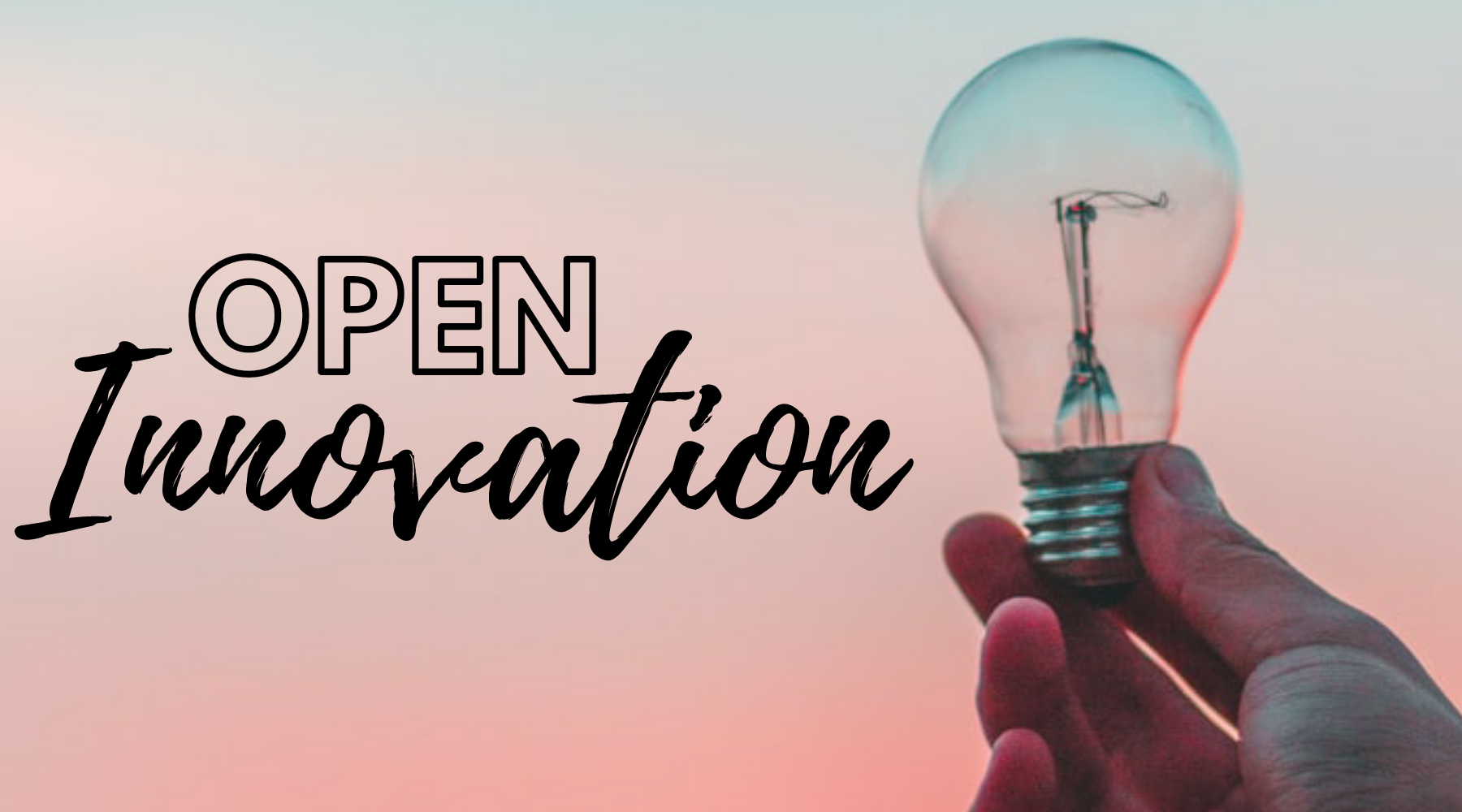Let’s discuss open innovation through a scenario. Would you say that all the smartest people in the world live in your company?
Thought not.
This may seem obvious. But, it is a prevalent misconception. It manifests in the way many companies do innovation. They leave all the creative work to employees alone.
Open innovation is an alternative to this conventional innovation process. Here information does not have to stay within preset confines. A mindset, if you will, of being open to sharing and receiving information.
There is much literature on the topic. But, much of it tackles the topic on a very abstract level, leaving room for interpretation. This is why we have decided to break down the topic for you in layman’s terms.
Our extensive and example-rich guide on open innovation is aimed towards guiding you to understand the concept through the following questions:
- What is open innovation?
- What are the benefits of open innovation?
- Also, what are the challenges of open innovation?
- How is open innovation done?
History of Open Innovation
In the 17th century, Europe’s six seafaring powers initiated a competition. It was to find a precise way to navigate the seas. They wanted a more accurate method of measuring time to find longitude, to be exact.
This competition inspired the great minds of the time to solve the dilemma. It included Galileo Galilei and Christiaan Huygens.
The problem was solved in the 18th century by an English clockmaker. This was, believe it or not, a very early form of open innovation.
Henry Chesbrough invented the term “open innovation” in 2003. He mentioned it in his book. It is a take on the benefits of innovating collaboratively with external parties. But the idea behind open innovation is much older than that.
Types of Open Innovation
Let us view the different types of open innovation that exist.
It forms a better picture of how open innovation can be used. It also works in anchoring this otherwise abstract topic to something more tangible.
We have decided to do this classification with a matrix. It represents levels of inclusion and purpose of use. This draws a clear-cut table on how open innovation can be used.
Level of Inclusion
We have narrowed the levels of inclusion down to 4 different types:
- Intracompany: Inside the company or organization. It can be considered a contradiction to the definition of open innovation itself. But it is a must to include this level inside a large organization. It is an open innovation to collaborate with different functions or business units.
- Intercompany: Between two or more different companies.
- For experts: All people outside the company. They have the required knowledge to give relevant input.
- Publicly open: This includes all people. This is regardless of previous knowledge or stature.
Purpose of use
We have selected the following four areas to define different use cases in companies:
- Marketing: Getting information across
- Gathering insight: This is valuable information on customers and the market.
- Finding talent: Scouting for talent.
- R&D: It is the most typical form where you develop services or products.
We get 16 different types of open innovation by cross-referencing these two dimensions.
Please note that this is just one way of looking at open innovation. But, it represents the different typologies and elements of open innovation quite well.
Benefits of Open Innovation
Here, we have cherry-picked the most generally applicable benefits of open innovation. These include examples of companies benefitting from them.
Suppose these benefits are (or could be) applicable in your situation. In that case, it may be a sign that open innovation is the way to go.
Engaging larger audiences
With open innovation, the audience size potential is vastly more extensive.
You want the input to be as extensive as possible. This is because you would for gaining insight into consumer buying habits. This is an everyday household item.
Here it is possible to expand the audience without any clear limits. Of course, it is a must to note that with broader participation comes higher costs.
For example, with their Ideas Site, Lego can engage consumers and fans worldwide. The fans can share their ideas for new products.
This way, Lego gets a better understanding of what customers want. They also get new exciting ideas.
Improving Cost efficiency
The costs in open innovation are likely to be smaller than the number of ideas and input. It is immensely profitable for companies in the downturn.
Internal innovation consumes work hours from employees. This is because they take part in managing the innovation process and its ideation.
In open innovation, the time used by employees goes towards managing the process.
In Netflix’s example, it is rewarding 1M USD to the team that can deliver a successful method. It was significantly cost-efficient.
It also reduced a failed investment risk. This is in contrast to attempting to develop this internally with no guarantee.
This is exemplified by the fact that they were not able to use the original winning algorithm. But they still had other excellent candidates from which to choose.
Involve customers in R&D
According to customer needs, designing products or services is always important, despite how open or closed the innovation process is.
But, open innovation additionally opens the door. It involves customers in the R&D process from the very beginning.
This increases the product’s viability as you get near-instant feedback regarding which aspects or features are necessary or useful to the end-user and which are not.
Customers usually form an important process of the organizational processes. This can be seen through a value proposition canvas.
Nivea’s B&W series was primarily developed on social media with the insights, comments, and feedback of consumers worldwide.
Engaging their actual customers in the development process helped Nivea understand early on which aspects of their product are crucial and focus on those.
A Chance for lucrative partnerships
When collaborating with external parties, mostly when this happens between two companies, there is potential for the birth of lucrative partnerships.
The intellectual property of one company may be utilized by the other (and vice versa). This may be done without too considerable an overlap in their respective markets. Such a partnership can be very symbiotic.
Both companies have much more creative potential at their disposal in such a situation.
Businesses can try to get new investors too. P&G exemplifies this win-win intercompany open innovation.
This is through their Connect and Develop -site. This is where they aspire to find mutually beneficial partnerships with other companies or private inventors.
Finding new talent
Open innovation can be an excellent tool for finding talent outside the company.
A broad outreach helps find and engage individuals perfect for the existing job opportunities, instead of selecting a “close enough” fit inside the company.
General Electric uses open innovation for this purpose via its GeniusLink Challenges, where people can submit their solutions and win prizes, some of which entail internships.
This selective process helps GE find the most talented individuals to later engage via job opportunities or paid internships.
Challenges of Open Innovation
By looking at the challenges that open innovation poses, it is easier to understand the coin; when not to use open innovation.
Without further ado, here are the everyday challenges of open innovation.
Unclear goals
Deciding to externalize innovation on an uneducated basis is risky as it could be the wrong fit. Thus, it is always vital to first chart your goals and assess whether open innovation is compatible with your situation.
For example, Mountain Dew may have had the goal of finding a new name for its green-apple product. Then the story could have had a happier ending if the design phase had accounted for the risk of trolling.
A good workaround could have been that an internal panel of judges decide the top 10 choices from all suggestions, after which users get to vote for the best one.
Then again, Mountain Dew’s goal may have been to market its new product. Then the design of the campaign was spot on.
The Wrong type of audience
Finding the right type or size of the audience may be tricky and poses a risk of sunk investment if done hastily or for the wrong reasons.
It is essential to understand what you wish to achieve and how you believe it is the best way to get there. Use that information to scope the external parties that can provide relevant information to reach your goals best.
Mountain Dew’s naming campaign works as a good example here as well.
If their goal was to find a new name, they had the wrong audience, as a public naming campaign is like a catnip to internet trolls. Then again, from a marketing perspective, the target audience was precisely right.
Diminishing returns
The longer you innovate, the more your returns will diminish over time.
Although an optimist would note that this means there were results for which to diminish in the first place, knowing how long to keep the project going poses a challenge.
It should be long enough to get your desired input, but short enough to retain cost-effectiveness.
Conclusion
Mostly, open innovation is a cost-effective and surgical tool for outsourcing ideas. This is true even during rough times. But sometimes it is an embarrassing void of sunk investment.
The difference between the two is understanding everything that came before, and then some.
The biggest mistake you can do with open innovation is ramming it into where it does not belong. You can try to achieve goals by executing an open innovation method without understanding why you are doing it.
Closed and open innovation both exist for a reason. Knowing these reasons will help you balance them out evenly, getting the best of both worlds.









